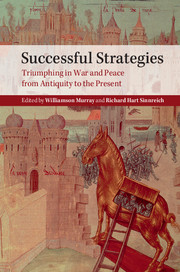Book contents
- Frontmatter
- Dedication
- Contents
- List of tables and map
- List of contributors
- Acknowledgments
- Introduction
- 1 The strategic thought of Themistocles
- 2 The grand strategy of the Roman Empire
- 3 Giraldus Cambrensis, Edward I, and the conquest of Wales
- 4 Creating the British way of war: English strategy in the War of the Spanish Succession
- 5 Failed, broken, or galvanized?
- 6 Victory by trial and error: Britain’s struggle against Napoleon
- 7 The strategy of Lincoln and Grant
- 8 Bismarckian strategic policy, 1871–1890
- 9 Dowding and the British strategy of air defense 1936–1940
- 10 US naval strategy and Japan
- 11 US grand strategy in the Second World War
- 12 American grand strategy and the unfolding of the Cold War 1945–1961
- 13 The Reagan administration’s strategy toward the Soviet Union
- Afterword
- Index
- References
11 - US grand strategy in the Second World War
Published online by Cambridge University Press: 05 June 2014
- Frontmatter
- Dedication
- Contents
- List of tables and map
- List of contributors
- Acknowledgments
- Introduction
- 1 The strategic thought of Themistocles
- 2 The grand strategy of the Roman Empire
- 3 Giraldus Cambrensis, Edward I, and the conquest of Wales
- 4 Creating the British way of war: English strategy in the War of the Spanish Succession
- 5 Failed, broken, or galvanized?
- 6 Victory by trial and error: Britain’s struggle against Napoleon
- 7 The strategy of Lincoln and Grant
- 8 Bismarckian strategic policy, 1871–1890
- 9 Dowding and the British strategy of air defense 1936–1940
- 10 US naval strategy and Japan
- 11 US grand strategy in the Second World War
- 12 American grand strategy and the unfolding of the Cold War 1945–1961
- 13 The Reagan administration’s strategy toward the Soviet Union
- Afterword
- Index
- References
Summary
The history of American strategic decision making before and during the Second World War is a clear example of first-rate strategy transforming the great power status of a state. In 1935, with United States in the throes of the Depression, the nation’s rise to superpower status seemed unlikely. Congress reflected the public’s deeply isolationist mood, enacting the first of a series of Neutrality Acts intended to keep the nation out of another European conflict. The US military, other than its navy, did not reflect the nation’s latent power. Most Americans neither expected nor desired world power. Yet in the space of just a single decade, this situation had completely altered. By 1945, the United States was one of the world’s two acknowledged superpowers. Its powerful armed forces had played a major role in the defeat of the Axis in battles spanning the globe. Its economy was by far and away the most powerful in the world. And American diplomacy in large measure shaped the postwar world – a world the United States would dominate in nearly every major category of power and influence.
These developments did not happen accidentally. They were, rather, the result of foresight and the creation of a successful strategy that guided American actions, from the neutrality of the interwar period to final victory in 1945. The architect was Franklin D. Roosevelt, a skillful politician who understood both domestic constraints and international realities in crafting American strategy. Roosevelt, ably advised by army chief of staff, General George C. Marshall and the other members of the joint chiefs of staff (JCS), skillfully guarded America’s neutrality, carefully managed its entry into the Second World War, and deftly shaped the contours of the postwar world – and did so without the massive national security bureaucracy that guides current administrations in their handling of foreign policy and military affairs.
- Type
- Chapter
- Information
- Successful StrategiesTriumphing in War and Peace from Antiquity to the Present, pp. 314 - 352Publisher: Cambridge University PressPrint publication year: 2014
References
- 1
- Cited by



